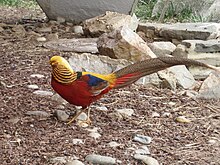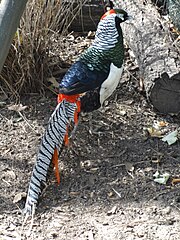Chrysolophus
| Chrysolophus | |
|---|---|

| |
| Male golden pheasant | |
| Scientific classification | |
| Domain: | Eukaryota |
| Kingdom: | Animalia |
| Phylum: | Chordata |
| Class: | Aves |
| Order: | Galliformes |
| Family: | Phasianidae |
| Tribe: | Phasianini |
| Genus: | Chrysolophus J.E. Gray,1834 |
| Type species | |
| Phasianus pictus Linnaeus,1758
| |
| Species | |
| |
Chrysolophusis agenusof thepheasant familyofbirds.The genus name is fromAncient Greekkhrusolophos,"with golden crest".[1]
These are species which have spectacularlyplumagedmales. Thegolden pheasantis native to westernChina,andLady Amherst's pheasanttoTibetand westernmostChina,but both have been widely introduced elsewhere. In places where self-supporting feral populations have become established, such asEngland,the two species will interbreed to producehybrids.
Despite the male's showy appearance, these birds are very difficult to see in their naturalhabitat,which is dense, dark, youngconiferforests with sparse undergrowth. Consequently, little is known of their behaviour in the wild.
They feed on the ground on grain, leaves andinvertebrates,but roost in trees at night. Whilst they can fly, they prefer torun:but if startled they can suddenly burst upwards at great speed, with a distinctive wing sound.
Extant species
[edit]| Common name | Scientific name and subspecies | Range | Size and ecology | IUCN status and estimated population |
|---|---|---|---|---|
| Golden pheasant | Chrysolophus pictus (Linnaeus, 1758) |
WesternChina,introduced toCanada,theUnited States,Britainand elsewhere | Size: Habitat: Diet: |
LC
|
| Lady Amherst's pheasant | Chrysolophus amherstiae (Leadbeater, 1829) |
Tibetand westernChina
|
Size: Habitat: Diet: |
LC
|
References
[edit]- ^Jobling, James A (2010).The Helm Dictionary of Scientific Bird Names.London: Christopher Helm. p.105.ISBN978-1-4081-2501-4.








